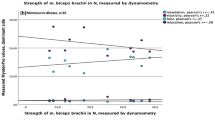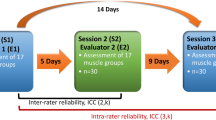Abstract
Severe clinical myotonia can be physically disabling and socially imparing but as yet there is no standardized treatment regimen. The aimn of our study is to present a protocol to measure myotonia using quantitative muscle assessment measures. The proposed protocol addresses two main issues. Muscle strength is assessed in 8 muscles on the right and on the left using a myometer (QMA, quantitative muscle assessment) and by testing strength manually using the 5-point MRC scale (5 = normal) in 15 muscles on the right and on the left. Grip myotonia is assessed by: (a) measuring 1/2 and 3/4 relaxation times (RT) after maximum voluntary contraction (MVC) using QMA apparatus; (b) functional tests (time to open a fist 10 times, time to open and squeeze the eyes 10 times, time to clim 10 steps starting from a seated position, time to protrude the tongue 10 times, time to step onto a chair 10 times; (c) subjective measures of the severity of myotonia using an arbitrary 4-point scale (0=absent, 4=severe); and (d) electromyography (EMG) relaxation times after MVC. Although QMA seems to be a reliable tool to measure myotonia, there are still a number of unsolved issues. Further studies are needed to ensure the ability of QMA to quantify myotonia and to guarantee the reliability of the results for clinical research purposes.
Similar content being viewed by others
Author information
Authors and Affiliations
Rights and permissions
About this article
Cite this article
Sansone, V., Marinou, K., Salvucci, J. et al. Quantitative myotonia assessment: an experimental protocol. Neurol Sci 21 (Suppl 3), S971–S974 (2000). https://doi.org/10.1007/s100720070012
Issue Date:
DOI: https://doi.org/10.1007/s100720070012




